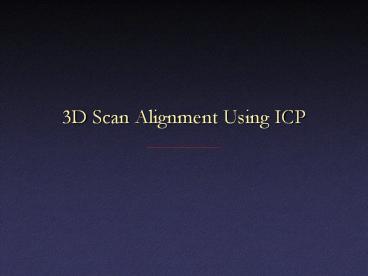3D%20Scan%20Alignment%20Using%20ICP - PowerPoint PPT Presentation
Title:
3D%20Scan%20Alignment%20Using%20ICP
Description:
3D Scan Alignment Using ICP Problem Align two partially- overlapping meshes given initial guess for relative transform Aligning 3D Data If correct correspondences are ... – PowerPoint PPT presentation
Number of Views:66
Avg rating:3.0/5.0
Title: 3D%20Scan%20Alignment%20Using%20ICP
1
3D Scan Alignment Using ICP
2
Problem
- Align two partially-overlapping meshesgiven
initial guessfor relative transform
3
Aligning 3D Data
- If correct correspondences are known, can find
correct relative rotation/translation
4
Aligning 3D Data
- How to find correspondences User input? Feature
detection? Signatures? - Alternative assume closest points correspond
5
Aligning 3D Data
- and iterate to find alignment
- Iterative Closest Points (ICP) Besl McKay 92
- Converges if starting position close enough
6
ICP Variants
- Variants on the following stages of ICPhave been
proposed
- Selecting source points (from one or both meshes)
- Matching to points in the other mesh
- Weighting the correspondences
- Rejecting certain (outlier) point pairs
- Assigning an error metric to the current
transform - Minimizing the error metric w.r.t. transformation
7
Performance of Variants
- Can analyze various aspects of performance
- Speed
- Stability
- Tolerance of noise and/or outliers
- Maximum initial misalignment
- Comparisons of many variants inRusinkiewicz
Levoy, 3DIM 2001
8
ICP Variants
- Selecting source points (from one or both meshes)
- Matching to points in the other mesh
- Weighting the correspondences
- Rejecting certain (outlier) point pairs
- Assigning an error metric to the current
transform - Minimizing the error metric w.r.t. transformation
9
Closest Compatible Point
- Closest point often a bad approximation to
corresponding point - Can improve matching effectiveness by restricting
match to compatible points - Compatibility of colors Godin et al. 94
- Compatibility of normals Pulli 99
- Other possibilities curvatures, higher-order
derivatives, and other local features
10
ICP Variants
- Selecting source points (from one or both meshes)
- Matching to points in the other mesh
- Weighting the correspondences
- Rejecting certain (outlier) point pairs
- Assigning an error metric to the current
transform - Minimizing the error metric w.r.t. transformation
11
Point-to-Plane Error Metric
- Using point-to-plane distance instead of
point-to-point lets flat regions slide along each
other Chen Medioni 91
12
Demo































